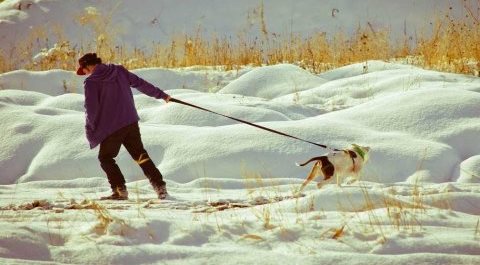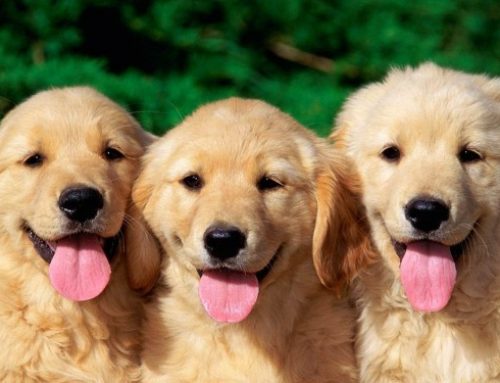Pet owners are sometimes convinced that their dog knows what they want it to do but is simply “too stubborn” to perform the behavior. Some of these pet owners may attempt to force their dog into a body position, and when the dog struggles due to confusion or fear, it is deemed “stubborn.” By labeling their dog this way, pet owners assume that the dog understands what behavior is desired and when to perform it. In reality, the dog’s lack of response is frequently due to a communication breakdown during training in the areas of learning, reinforcement, and cuing.
Your Dog Isn’t Stubborn: He Hasn’t Learned the Behavior
In VIDEO 1, River is told to get off the couch, but he has never been taught “off.” His confusion and mild distress are shown when he (1) lies down and sniffs himself when asked to get “off,” (2) leans away from being grabbed, and (3) “shakes off.” River is screaming in dog language, “I don’t know what you want!” In this video, I see a dog that is tolerant and confused, not stubborn.
Teaching a behavior consists of observing the behavior, marking it, reinforcing it, and putting it on a cue. A behavior has been learned when it becomes highly predictable.
Owners should be taught to recognize the behavior they want instead of waiting for undesirable behavior to occur. This usually requires a dramatic transformation in an owner’s thought and teaching processes. Owners are routinely imprecise in communicating a goal behavior to their dog and inconsistent in rewarding the behavior. Therefore, dogs must often guess what is expected of them, learning through trial and error despite owners’ inconsistencies. Including punishment in the training exacerbates confusion and inconsistency and can create a motivational conflict in the learning process.
Teaching Basics
Shaping
By marking an exact behavior with a sound (e.g., click, word), a marker signal can tell an animal precisely which behavior is being reinforced. Correct timing of the signal is important for clear communication. For correct timing, the trainer must know the goal behavior and the steps for getting to the behavior; these steps are called shaping. The dog’s role is to offer a behavior. The trainer’s role is to choose which behavior to mark and reward. This requires thought and planning by the trainer:
• What will the final behavior look like?
• What are the steps for getting to the final behavior?
Shaping means to progressively change a behavior by deliberately reinforcing stronger responses and omitting weaker responses. By doing this, a trainer helps an animal sort out what works and what does not. A trainer should have a step-by-step training plan, including which criteria are required for the animal to receive reinforcement (FIGURE 1).
When an animal understands which specific behavior is being marked, its behavior becomes purposeful and confident. The animal’s enthusiasm increases because it correctly anticipates enjoyable consequences.
Capturing
Capturing means observing an animal’s behavior and selectively clicking (reinforcing) behaviors that will lead to the goal behavior. Often, an initial behavior (e.g., a head turn to the right) is captured and then shaped into a more exaggerated behavior (e.g., an entire body turn to the right). Capturing is a very rewarding and fascinating training method. It is amazing to watch an animal and trainer work as a team to get to the goal behavior.
Fluency
A behavior is considered fluent when it can be performed with speed and accuracy in any environment. Different aspects of fluency are described below.
Precision: The final look of the desired behavior (e.g., “Put the telephone in my hand when it rings”).
Latency: The time between the cue being given and the animal beginning to perform the behavior (e.g., the dog gets the phone by the second ring [the ring is the cue for the behavior]). Decreased latency should be shaped in various environments.
Speed: The time it takes to complete the behavior (e.g., the dog delivers the phone before it stops ringing). The appropriate speed of the behavior should be shaped.
Distraction: Anything that interrupts the behavior. The behavior should be performed despite distractions (e.g., the dog doesn’t drop the phone to chase the cat). Real life is filled with distractions, but this area of fluency is usually the most neglected by owners.
Duration: The length of time during which the behavior is performed (e.g., the dog should be able to hold the phone without dropping it).
Distance: The distance between the dog and the trainer. The dog should perform the behavior even when the trainer is farther away from the dog (e.g., the dog gets the phone regardless of where the owner is standing).
Your Dog Isn’t Stubborn: He Hasn’t Been Reinforced Properly
Reinforcers (e.g., treats) must be valued by the dog, and reinforcement variety (e.g., verbal praise, petting, various types of treats) improves the learning process. A reinforcement hierarchy should be created so that more difficult tasks are rewarded with higher-value reinforcement. In other words, if a task is difficult, “pay” the animal more for the “job.” In reality, the trainer does not decide what is reinforcing; the dog does. However, a trainer can manipulate the value of reinforcers, such as teaching a dog to eat a bit of kibble by following it with a piece of hot dog as in, “If you eat your vegetables, you will get dessert.”
Reinforcement (e.g., a click) is information for an animal. Incorrect information is delivered to an animal when opportunities for reinforcement are missed, timing is incorrect, or criteria are haphazard. When these occur, the learning process becomes frustrating or even punishing to an animal.
A high rate of reinforcement can be maintained by knowledgably and considerately raising and lowering the criteria for reinforcement to keep the learner interested and enthused and the rate of learning steady. The higher the rate of reinforcement, the more information the animal is given. A base rate of reinforcement per minute should be determined. A decline in the rate may indicate that the criteria need to be adjusted to increase the rate. Owners routinely do not reinforce their animals enough, missing many opportunities for reinforcement.
Your Dog Isn’t Stubborn: He Doesn’t Understand When To Perform the Behavior
A cue precedes a behavior, telling an animal that a reinforcement opportunity exists. A cue can be almost anything: movement, sound, sight, presentation of an object, or even a scent. An effective cue is consistent, easily perceived by an animal, and not easily confused with other cues. Cues can be used to differentiate behaviors. A cue is not a command to do a behavior but is a signal to perform a specific behavior with the chance of reinforcement. A command implies threat: do the behavior or else. Cues are reinforcing in themselves. In Reaching the Animal Mind,1 Karen Pryor compares cues to a green light at a traffic stop:
Think about that little sense of joy or relief you feel when the traffic light turns green; that’s a cue, identifying a behavior that you want to do. Every cue is a green light, permission to go do the thing it names. The cue thus becomes reinforcing in itself. Any time you give a well-learned cue, you are actually reinforcing whatever else the individual you are cuing happens to be doing at the time.1
Imagine living in a country where you did not understand the language but you suddenly heard a word or phrase you did understand. You would feel relief because you knew what that meant! Think of cues as terminology with a meaning that is agreed on by a trainer and an animal.
The Clever Hans Effect
In 1904, Wilhelm von Osten, a retired math teacher, was convinced that his horse Clever Hans could solve addition, subtraction, multiplication, and division problems. Clever Hans was asked questions for which the answers could be converted into a number that Hans could tap out with his hoof. A panel of experts, including veterinarians, circus trainers, zoologists, physiologists, and psychologists, determined that Clever Hans was definitely answering the questions without being influenced by outside interference. Subsequently, researcher Oskar Pfungst created an environment in which Clever Hans was isolated from outside distraction and stimuli, including observers. Pfungst found that when he gave a questioner an answer that was incorrect or when Clever Hans could not see the questioner, Hans’ number of correct answers dramatically declined. Pfungst noted that Hans became agitated when he could not see the questioner. Pfungst determined that although Clever Hans was a very bright, astute horse, he was actually being cued by very subtle facial and body changes of audience members and questioners as his hoof taps approached the correct response. Clever Hans was perceiving involuntary postural changes (e.g., body tensing, head raising, eyebrow twitching, nostril dilation) as cues. Pfungst proved that Hans could perceive head movements as subtle as 0.2 mm as a cue for reaching the correct number of hoof taps.
Like Clever Hans, a dog can detect environmental subtleties that often inadvertently become cues to perform behaviors. Owners think their dog has been taught to lie down when they say, “Down,” but the cue is actually nonverbal (e.g., pointing at the floor). Dogs learn the most noticeable or salient cues, with movement being more salient than sound in most cases. Owners often do not realize that they are giving other signals (e.g., wiggling the leash, inconsistent or multiple movements); even consistently having a treat in hand when asking for a behavior can become a cue.
Adding Cues
No amount of saying “sit” will teach a dog what “sit” means. Likewise, yelling “sit” repeatedly will not make a dog sit. Instead, waiting for a dog to sit on its own, signaling to the dog that it was correct, and reinforcing the behavior allows the dog to learn the behavior before naming the behavior (i.e., giving it a cue).
Determine the cue to be used. When the behavior you are putting on cue occurs consistently with intention and intensity, add the cue just before the behavior occurs. Some trainers aspire to a specific rate of reinforcement, such as 10 behaviors per minute, before adding a cue to the behavior.
The steps for adding a cue may go as follows:
• Dog offers behavior; click and treat (C/T)
• Dog offers behavior; C/T
• Trainer gives cue; dog offers behavior; C/T
• Trainer gives cue; dog offers behavior; C/T
• Trainer does not give cue; dog offers behavior; no reward
• Trainer gives cue; dog offers behavior; C/T
• Trainer pauses, gives cue; dog offers behavior; C/T
• Trainer pauses, pauses, gives cue; dog offers behavior; C/T
• Trainer gives cue; dog offers behavior; C/T
The steps should continue until the dog realizes that without the presence of the cue, the behavior will not be reinforced.
Generalizing means the animal understands that the cued behavior is the same regardless of other variables (e.g., a change in the environment or the trainer’s body position). A behavior that has been placed on cue in the living room will need to be retrained by temporarily lowering the reinforcement criteria in the new location.
Testing for Stimulus Control
A behavior is under the influence of a cue and considered to be under stimulus control when the following conditions are met:
• The cue is given; the behavior occurs
• The cue is not given; the behavior does not occur
• The cue is given; a behavior other than the desired behavior does not occur
• A different cue is given; the behavior does not occur
Here is an example of testing for stimulus control for the behavior of lying in sternal recumbency with the verbal cue “down”:
√ Verbal “down” cue = down behavior
√ The trainer stands quietly = no down behavior
X Verbal “down” cue = the dog sits
X The trainer points to the ground = the dog sits
The verbal cue “down” is not under stimulus control.
Once a behavior is on a cue, under stimulus control, and fluent, a clicker is no longer required to obtain the behavior.
Conclusion
Stating that an animal “is too stubborn” to perform a behavior is an anthropomorphic excuse rather than a scientific explanation for the lack of response to a requested behavior. The absence of a response or the performance of an incorrect response is most likely due to a lack of training, mistraining, or a breakdown in communication during training. One or more of the following deficits have likely occurred:
• The animal does not “know” what behavior is desired because the behavior has not been trained properly or to fluency.
• The reinforcement was timed incorrectly, not rewarded, or given at a rate that was too low.
• The behavior is not on cue or not on the cue that the trainer thinks it is.
Veterinary technicians can play an important role in teaching effective, humane, and scientific training methods to pet owners.



